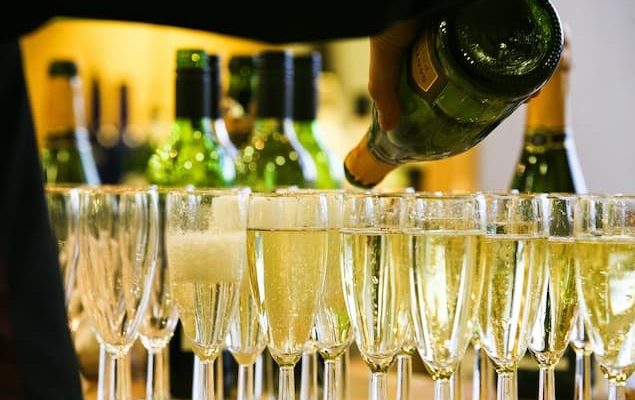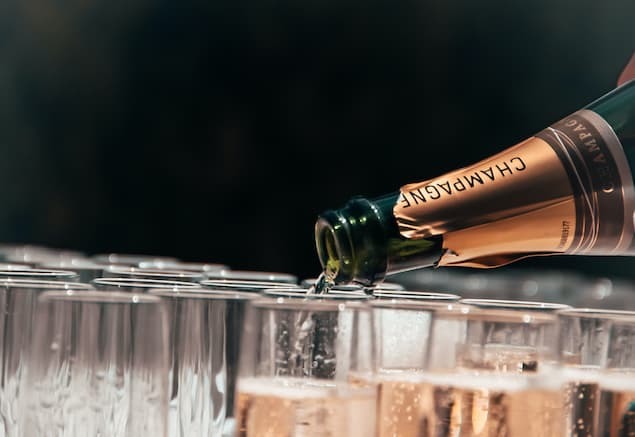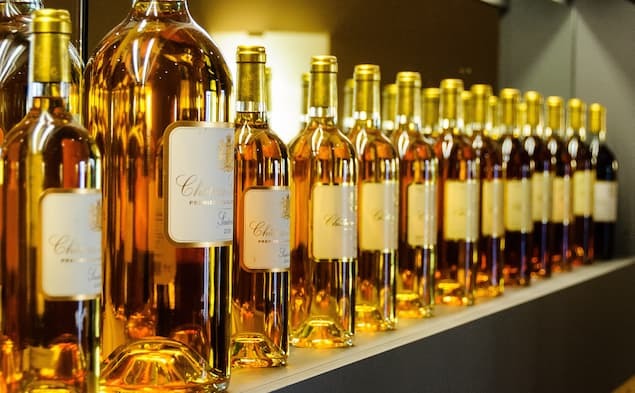The Weird World of Specialty Wines: Sparkling, Fortified, And Sweet
Most wines are pretty straightforward. But others are… different.

Most wines are pretty straightforward.
But others are… different. They’re different because although they’re made with largely the same ingredients and with the same fundamental process, a slight tweak to either can generate a much different result. And that result can challenge our concepts of what we consider as wine.
Sparkling wines. Fortified wines like Sherry and Port. Dessert wines. All are technically wines, but each feature either a different production process or ingredient that sets them apart from your everyday “table” wine.
While these slight tweaks are now deliberate production methods used to create a desired result, in many cases their origins were a “happy accident” that was not expected or planned.
At Uncorked Kitchen’s recent wine class Sparkling and Speciality Wines, we had the opportunity to taste a little of each, exploring how they’re made, how they came about, and how to pair them with food.

Sparkling Wine
Sparkling wines are simply wines that contain bubbles. The most commonly known types are Champagne and Prosecco. What differentiates them is where they’re from, how those bubbles are formed, as well as the varietal used.
Champagne is a region in the north of France, and technically only wine produced in that region can carry the label. The grapes used in Campagne include Chardonnay, Pinot Noir, and Pinot Meunier, usually a blend.
Prosecco is made in Italy, using Prosecco (or Glera) grapes, also primarily grown in the northern regions (although not as high north as Champagne). The northern climates of both wines are cooler than average, resulting in grapes that are less ripe, and therefore more acidic and crisp.
Both have bubbles. But how those bubbles are formed makes a huge difference in not only the price, but the experience.
The bubbles in sparkling wines are formed by carbon dioxide generated during a two-fermentation process. In both Champagne and Prosecco, the base wine is first fermented in a tank like all other wines. Then there’s a second fermentation involving the addition of sugar and yeast. The yeast eats the sugar and forms carbon dioxide as the result.
In Champagne, this second fermentation occurs in the bottle, while in Prosecco it occurs in the tank. There are several consequences of these differences. Most immediately noticeable is the price. Traditional bottle fermentation is labor-intensive, and thus expensive. Tank fermentation is easier, and therefore cheaper.
But the difference is more than the price. In Champagne, the dead yeast used to create the bubbles (called “lees”) is directly in the bottle, and therefore more concentrated. That gives Champagne more body and produces a richer, buttery-er, and more structured wine.
Prosecco meanwhile is a lighter wine, typically sweeter and fruit-forward. They’re more effervescent wines characterized by a more youthful, fresh and crisp taste.
Both Champagne and Prosecco are highly enjoyable on their own, and work particularly well as an aperitif… brightening the palate before a meal. But both are great with food as well.
For Champagne think fatty/creamy cheeses, shellfish like lobster, raw bar options like oysters, and even fried foods. Believe it or not but Champagne goes great with fried chicken and potato chips! Prosecco’s sweetness pairs great with charcuterie plates, fruits, and provides a great contrast with the species in Asian cuisine.
Fun Fact:
Champagne is believed to have originated by accident. The weather in northern France is so cold that it naturally paused the fermentation process over the winter, and restarted in spring when temperatures warmed, causing unexpected bubbles to form. The French monk Dom Perignon is credited for turning that “happy accident” into a standardized process.
Other sparkling wines include:
- Lambrusco: a red sparkling wine that can be either dry or sweet depending on production.
- Pet Nat: or “petillant naturel” is a natural, milder unfiltered wine that allows bubbles naturally, as it was bottled before the initial fermentation was complete… without a second fermentation.
- Cava: a white or red sparkling wine from Spain, made in the traditional Champagne style similar to Champagne.

Fortified Wines
Stretching the traditional definition of wine is the category of fortified wines. I say stretch because the result of fortifying a wine is far more unique than just adding bubbles to a white still wine.
Fortified wines are created by adding a grape-based distilled spirit (typically brandy) to the winemaking process. The addition of alcohol either kills the yeast used to ferment the wine and makes it sweeter or is used post-production as a preservative. It also raises the alcohol content, and affects the flavor.
Fortifying wine with alcohol began as a way to preserve wine for long sea journeys. With the advent of more modern preservation techniques (not to mention faster transportation methods), what began out of necessity continues out of preference.
The class focused on the three main types of fortified wine — Sherry, Port, and Madeira.
Sherry
Sherry wines hail exclusively from Spain, where it is not only fortified with brandy, but also aged in a complicated “solera” system where the sherry moves through a pyramid of different barrels in a fractionalized blending process. As a result, Sherry wines don’t have vintages.
We tasted two types of Sherry: fino and oloroso. Finos are typically not exposed to oxygen during fermentation, resulting in a lighter, drier Sherry. Oloroso Sherry, meanwhile, is exposed to oxygen, and as a result has a nutty, caramelized flavor and can be heavier, almost thicker, and sweeter.
In our tasting, the fino was very dry, almost briny, and frankly a challenge to drink by itself. But paired with olives, almonds, and other savory-like snacks, it balanced out nicely. The oloroso was much easier to drink on its own, sweet but also earthy, and was a great compliment to parmesan cheese.
Port
Port is a fortified wine from Portugal. It also is spiked with alcohol to stop fermentation, but in this case is done during the middle of fermentation (rather than towards the end of fermentation as with Sherry), and as such is much sweeter than Sherry. Port can also be made from either white or red grapes, while Sherry is exclusively white.
Port also has two main types: Tawny and Ruby. The Tawny style is aged longer (10-40 years), in smaller casks with some oxygen exposure, and as a result are lighter in color but typically more complex in flavor. Ruby Ports, meanwhile, are younger, aged in larger casks, and are notable for their namesake deep red color.
The Ruby we tried paired incredibly well with chocolate, while the Tawny complimented a peanut brittle fabulously.
Madeira
Madeira is a wonderfully unique wine, named after Portugal’s Madeira islands, that is higher in sugar (and naturally, sweetness) than the above.
Madeira is higher in sugar. Sweeter. It’s earned the nickname “zombie” or “vampire” wine because it is nearly impossible to kill. Madeira barrels are exposed to high heat, aging in the sun to force an almost hyper-oxidation process that allows it to keep forever.
This is one of those “happy accidents” where wine transported by sea was exposed to the same kind of high heat (plus the roiling of the ships) which transformed what was “regular” wine into what has become Madeira.
Drinking it is almost akin to sipping rum.
Other fortified wines included:
- Marsala
- Mistelle
- Moscatel
- Vermouth
- Commandaria

Dessert Wines
Finally, we tried a dessert wine called Vin Santo. Dessert wines aren’t fortified. Their sweetness comes not from the winemaking process, but from the grapes. These sweeter grapes get that way through either environmental factors or harvesting conditions, either of which produce juice with a higher concentration of sugar that results in sweeter wines.
For instance ice wine is a dessert wine featuring grapes that have been left to freeze on the vine. The frozen grapes are very gently pressed, leaving behind the frozen water content and extracting the syrupy, sugary juice for fermentation. Sauternes meanwhile gets its sweetness from the development of a fungus called botrytis. Others are made from dried grapes (think raisins, but not exactly) where the drying process concentrates the sweetness.
Vin Santo is an Italian dessert wine (translation: “holy wine”) traditionally from Tuscany that features this dried-grape process. After harvest, the grapes rest on straw mats (hence the nickname “straw wines'') where they evaporate and dry. The longer the drying, the more concentrated the sugars in the wine become, resulting in a sweeter wine.
When pairing dessert wine with food, the rule of thumb is to make sure the wine is sweeter than the dessert, or it’ll taste bitter. In class, the Vin Santo was a pleasant complement to the traditional Italian cookie biscotti.
Fun Fact:
Sauterne is the most famous dessert wine of all, and one of the most expensive wines to ever sell at auction. A Chateau d’Yquem sold at an auction in 2011 for $117,000!
—
WHY JOIN US FOR A WINE-TASTING CLASS?
The benefit of a wine tasting class like Sparkling and Specialty Wines is that it introduces new wine concepts and flavors to participants in an approachable way. We tasted nine different styles of wines, across a wide spectrum of production methods—sparkling, fortified, and dessert.
The cost alone of buying each type of bottle featured in this class would dissuade even the most obsessed wine researcher from attempting this at home. Sure it would be more cost-effective to just buy and try one at a time. But then you miss out on the benefit of side-by-side pairing and contrasting. Uncorked Kitchen’s wine classes are developed for exactly this kind of comparison and conversational education. Take a look at our calendar and see what next area of wine you’d like to explore yourself.
Antony Bruno is a Colorado-based veteran storyteller, writer and editor. After 30 years of writing about the intersection of technology and culture, he’s spending the next 30 writing about food, wine, travel, and adventure.
Ready to experience a wine tasting? Uncorked-style? Check out our calendar of upcoming wine tastings today.
Hours
Closed Monday
Tuesday-Friday 3pm–10pm
Saturday 12pm-10pm
Sunday 12pm-6pm
HAPPY HOUR
Tuesday-Friday 3pm–6pm
Sunday 12pm-6pm

